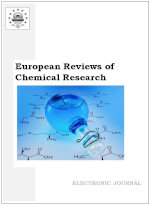1 March 31, 2016
Articles and Statements
1. Irina A. Glukhova, Larisa N. Maskaeva, Vyatcheslav F. Markov, Stanislav S. Tulenin, Anna I. Shemyakina
Hydrochemical Deposition of Cu2S Films Using Thiocarbamide
European Reviews of Chemical Research, 2016, Vol.(7), Is. 1, pp. 4-9.
Number of views: 2071 Download in PDF
2. Ignat Ignatov, Oleg MosinEuropean Reviews of Chemical Research, 2016, Vol.(7), Is. 1, pp. 4-9.
Abstract:
Hydrochemical deposition of the films of stoichiometric composition Cu2S was determined in ammoniac and acetated layer systems by energy-dispersive elemental analysis. The film composition almost corresponds to formula unit Cu2S. Electron-microscopic research of the film morphology showed that the particles, which are formed the films of Cu2S have average size ~10 nm. The authors conclude that: 1. Nanocrystal films of copper (I) sulfide with the thickness 100±10 nm exhibiting good adhesion to sitall substrate were obtained by hydrochemical deposition in systems «CuSO4 – NaAc – CS(NH2)2» and «CuSO4 – NH3 – CS(NH2)2». EDX analysis confirmed that at hydrochemical deposition the formation of thin Cu2S film phase which is closed to stoichiometric composition
Hydrochemical deposition of the films of stoichiometric composition Cu2S was determined in ammoniac and acetated layer systems by energy-dispersive elemental analysis. The film composition almost corresponds to formula unit Cu2S. Electron-microscopic research of the film morphology showed that the particles, which are formed the films of Cu2S have average size ~10 nm. The authors conclude that: 1. Nanocrystal films of copper (I) sulfide with the thickness 100±10 nm exhibiting good adhesion to sitall substrate were obtained by hydrochemical deposition in systems «CuSO4 – NaAc – CS(NH2)2» and «CuSO4 – NH3 – CS(NH2)2». EDX analysis confirmed that at hydrochemical deposition the formation of thin Cu2S film phase which is closed to stoichiometric composition
Number of views: 2071 Download in PDF
The Reactions of Condensation–Dehydration Occurring in Aqueous Alkaline Solutions at Рн = 9–11 and T = 65–95 0C in the Process of Modeling of Primary Hydrosphere
European Reviews of Chemical Research, 2016, Vol.(7), Is. 1, pp. 10-27.
Number of views: 2015 Download in PDF
3. European Reviews of Chemical Research, 2016, Vol.(7), Is. 1, pp. 10-27.
Abstract:
The reactions of condensation–dehydration occurring in alkaline aqueous solutions at t = 65–95 0C and рН = 9–11, resulting in synthesis from unorganic molecules the larger organic molecules as polymers and short polipeptides in the process of modeling of primary hydrosphere, were discussed, as well as the possible mechanisms of the deuterium accumulation in form of HDO in hot water. For this aim we performed experiments with hot mineral water and seawater from Bulgaria and water with varying content of deuterium using IR- and DNES-spectroscopy. As model systems were used cactus juice of Echinopsis pachanoi and Mediterranean jellyfish Cotylorhiza tuberculata. It was demonstrated that hot alkaline mineral water with temperature from +65 0C to +95 0C and the pH value from 9 to 11 is more suitable for the origination of life and living matter than other analyzed water samples. In hot mineral waters the local maximums in IR-spectra are more manifested compared to the local maximums obtained in IR-spectra of the same water at a lower temperature. The difference in the local maximums from +20 0C to +95 0C at each +5 0C according to the Student t-criterion makes up p < 0,05.
The reactions of condensation–dehydration occurring in alkaline aqueous solutions at t = 65–95 0C and рН = 9–11, resulting in synthesis from unorganic molecules the larger organic molecules as polymers and short polipeptides in the process of modeling of primary hydrosphere, were discussed, as well as the possible mechanisms of the deuterium accumulation in form of HDO in hot water. For this aim we performed experiments with hot mineral water and seawater from Bulgaria and water with varying content of deuterium using IR- and DNES-spectroscopy. As model systems were used cactus juice of Echinopsis pachanoi and Mediterranean jellyfish Cotylorhiza tuberculata. It was demonstrated that hot alkaline mineral water with temperature from +65 0C to +95 0C and the pH value from 9 to 11 is more suitable for the origination of life and living matter than other analyzed water samples. In hot mineral waters the local maximums in IR-spectra are more manifested compared to the local maximums obtained in IR-spectra of the same water at a lower temperature. The difference in the local maximums from +20 0C to +95 0C at each +5 0C according to the Student t-criterion makes up p < 0,05.
Number of views: 2015 Download in PDF








